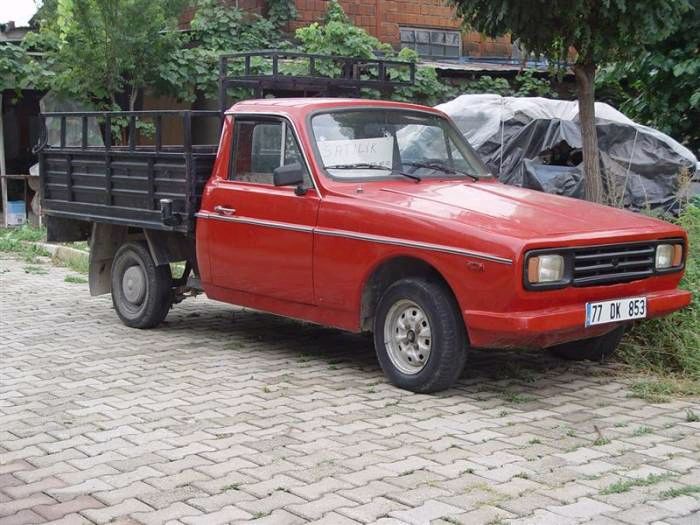In the early 1980s, Turkey’s automotive landscape was experiencing a remarkable transformation. Against this backdrop, one vehicle stood as a testament to the country’s industrial ambition — the Anadol Pikap P2 500 1.6. This wasn’t just another pickup truck; it represented Turkey’s bold step into automotive manufacturing independence.
The story of the P2 500 1.6 is intertwined with Turkey’s journey toward industrial self-reliance. As one of only 1,013 units produced between 1983 and 1984, each vehicle carried the weight of national pride and technological progress on its sturdy frame.
The Birth of a Turkish Legend: Origins and Development
The P2 500 1.6’s development marked a crucial phase in Anadol’s history. Launched in 1982, this model emerged from a necessity to create a versatile commercial vehicle that could handle both urban deliveries and rural workloads. The 1983 variant particularly stood out for its refined engineering and improved capabilities.
Historical Reference!
Anadol's journey began in 1966, making it Turkey's first mass-produced automobile manufacturer. The P2 500 1.6 represented the culmination of nearly two decades of automotive expertise, coming just before the company's transition to licensed production under Ford Motor Company.
“The P2 500 was more than a utility vehicle — it was a symbol of Turkish industrial capability. Its design reflected a deep understanding of local market needs,” notes Dr. Mehmet Yilmaz, Automotive Historian at Istanbul Technical University.
The development team faced unique challenges, particularly in balancing performance with cost-effectiveness. This led to innovative solutions, including the strategic reuse of proven 1.6-liter engines in the 1983-84 production run.
Engineering Excellence: Under the Hood
The P2 500 1.6 showcased impressive engineering for its era. The 1.6-liter gasoline engine, while not revolutionary, delivered reliable performance with a top speed of 140 km/h — a significant improvement over its predecessor’s 120 km/h.
Key technical specifications include:
- engine displacement: 1.6 liters with inline-four configuration;
- power delivery: rear-wheel drive with robust transmission;
- curb weight: 850 kg, enabling impressive payload capacity;
- dimensions: 4300mm length, 1645mm width, 1440mm height.
Fact!
The 1983 model year saw the introduction of a specialized 600D variant featuring a 1.9-liter diesel engine, requiring a distinctive hood bulge to accommodate the larger powerplant — a testament to Anadol's engineering adaptability.
Design and Practicality: A Closer Look
The P2 500 1.6’s design prioritized functionality without sacrificing character. Its distinctive profile, with clean lines and practical proportions, reflected Turkish automotive design philosophy of the early 1980s.
“My father’s P2 500 served our family business for over 15 years. Its reliability and practical design made it indispensable for our daily operations,” shares Ahmet Kaya, second-generation owner of a Istanbul-based delivery service.
Notice!
The vehicle's 850kg curb weight combined with its robust construction allowed for impressive payload capacity, making it particularly popular among small business owners and agricultural operators.
The two-seater cabin offered straightforward ergonomics and durability, with materials chosen for longevity rather than luxury. This pragmatic approach resonated strongly with its target market.
Market Impact and Legacy
The timing of the P2 500 1.6’s release proved significant. As Turkey’s economy underwent transformation in the early 1980s, the vehicle filled a crucial market niche.
Important!
With only 1,013 units produced during 1983-1984, the P2 500 1.6 has become increasingly sought after by collectors, particularly those interested in pioneering Turkish automotive history.
The model’s influence extended beyond sales figures. It demonstrated Turkey’s capability to produce commercial vehicles that could compete with international offerings, paving the way for future developments in the country’s automotive sector.
A Pioneer’s Enduring Influence
Today, the Anadol P2 500 1.6 stands as more than just a historical footnote. It represents a crucial stepping stone in Turkey’s automotive journey, bridging the gap between early industrialization and modern manufacturing capabilities.
Its legacy continues to influence discussions about Turkish industrial development and serves as a reminder of the country’s automotive heritage. The P2 500 1.6 proved that domestic manufacturers could create vehicles that met both local needs and international standards.
| Pros | Cons |
|---|---|
| Historically significant as part of Turkey’s first mass-produced vehicle line | Limited production run of only 1,013 units |
| Improved performance over predecessor (140 km/h top speed) | Used older engine technology to reduce costs |
| Robust construction with practical payload capacity | Limited seating capacity (2 seats only) |
| Excellent reliability and durability | Basic interior amenities by modern standards |
| Strong cultural significance in Turkish automotive history | Limited availability of spare parts today |
| Versatile design suitable for both urban and rural use | Less powerful compared to contemporary international models |
| Relatively lightweight at 850 kg | Minimal safety features by current standards |
The Anadol P2 500 1.6 embodies a unique moment in automotive history when Turkish industry was asserting its independence. While it may not match modern vehicles in terms of technology or comfort, its historical importance and role in Turkey’s industrial development make it a fascinating subject for enthusiasts and historians alike. Its limited production run and cultural significance have elevated it from a simple utility vehicle to a cherished piece of automotive heritage.

